The Forgotten Fists of Taekwondo
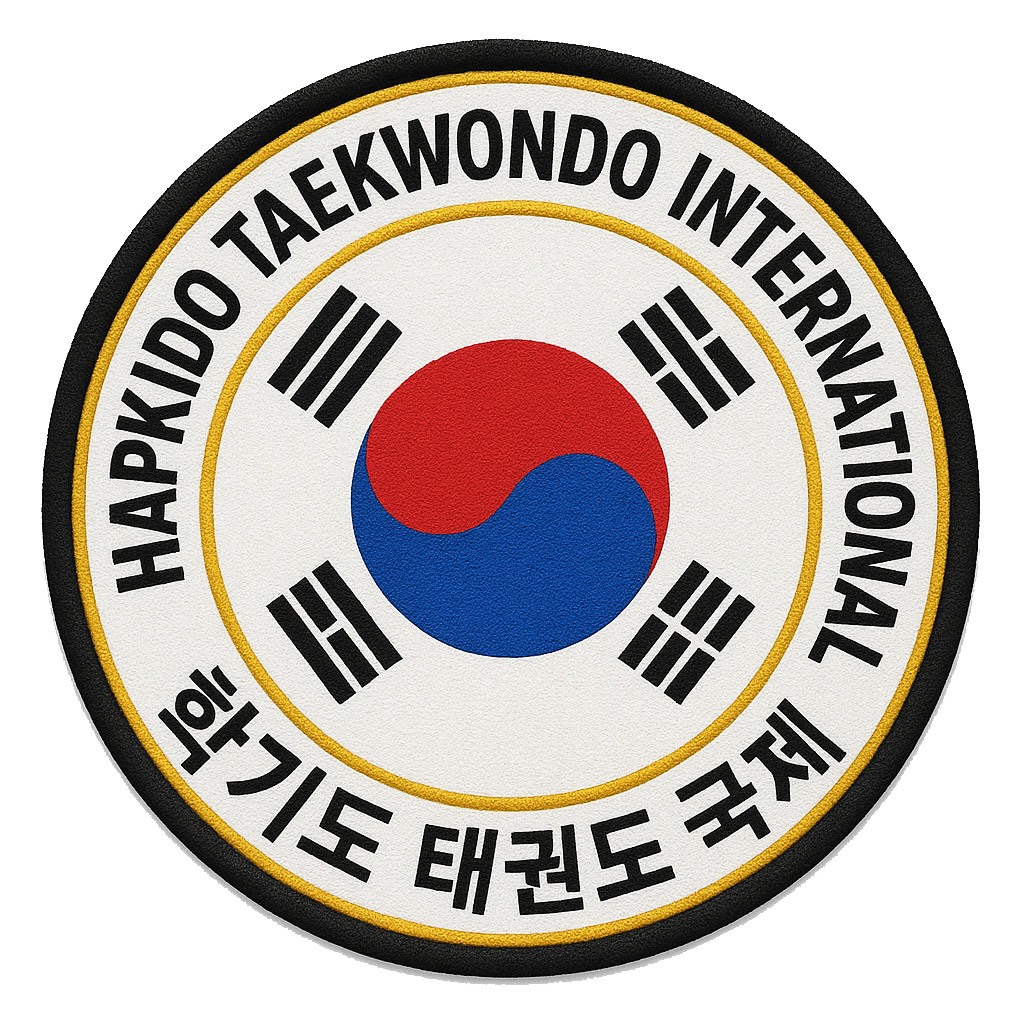

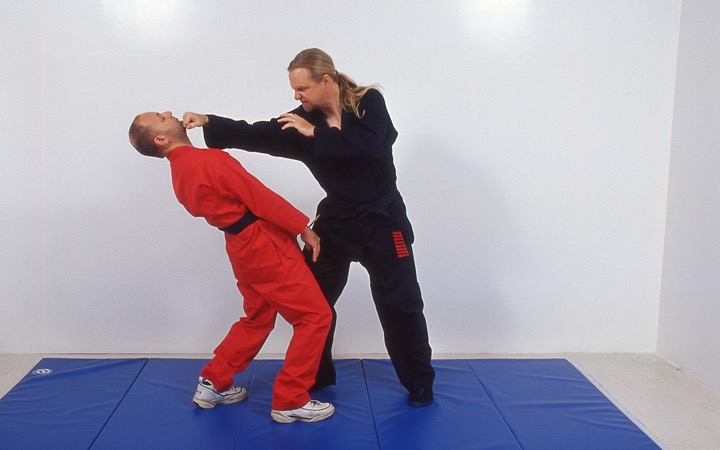
The Forgotten Fists of Taekwondo
This article originally appeared in the June 2009 issue of Black Belt Magazine.
By Scott Shaw
Taekwondo has long been defined by its advanced kicking techniques. But, taekwondo is much more than simply a martial art that places its primary focus upon the legs. At the heart of taekwondo is an exacting system of self-defense that employs all parts of a practitioner’s body. This is done so that the practitioner can be confident and emerge victorious from whatever type of physical altercation they may encounter.
Throughout the early evolution of taekwondo, from the mid 1940s forward, its self-defense techniques were continually reviewed and redesigned in order to make taekwondo an exacting science of self-defense. During the latter part of the twentieth century, however, taekwondo evolved into an Olympic sport. From this came many rules and regulations that began to alter the evolution of this self-defense orientated style of martial arts. Most noticeably was the fact that many of the original hand and arm strikes, that were elemental to the foundation of the original art of taekwondo, began to be toned down and in many cases eliminated altogether. This was due to the fact that in Olympic style taekwondo competitions, the punch is never allowed to be delivered to an opponent’s face or head. Punching and other hand techniques are restricted solely to an opponent’s body.
With the inauguration of the sport of taekwondo, this has caused many modern taekwondo instructors to veer their curriculum away from the traditional self-defense aspects of taekwondo and focus their training primarily upon the sport facets of the art. There has been much controversy associated with this redefinition — especially among the early practitioners of the art. This is due to the fact that many believe that by training a taekwondo student to focus their hand striking techniques solely upon the body of an opponent, the natural reaction to strike to the more debilitating locations on the opponent’s neck and head will be hindered if they ever encounter true combat.
Hidden Inside the Forms of Taekwondo
It must be understood that taekwondo was developed to utilize all elements of the practitioner’s body in the most efficient and effective manner possible. Simply by looking at the forms (poomse) of taekwondo, one immediately sees that there are low kicks to the legs, punches to the head, knife hands to the throat, and elbow strikes to the temples.
With the dawn of Olympic sport taekwondo, some teachers have moved away from training their students in the actual self-defense applications detailed in these forms. Instead, they have left the hand and arm strikes only to be practiced during the forms segment of a taekwondo class. This has caused speculation on the part of many novice taekwondo students as to how to actually use the hand and arm techniques detailed in the forms. This has given birth to a school of thought that there are secret elements, known only to the masters, hidden within the forms of taekwondo. This is not the case, however. The only reason this myth persists is based upon the fact that some modern taekwondo teachers no longer embrace the essential self-defense applications detailed in the forms of taekwondo. Instead, they have shifted their focus to training their students solely on the limited applications of sport taekwondo.
It must be understood that by not embracing the entire system of self-defense, detailed in the original definition of taekwondo, many students have been left with a less than adequate understanding of self-defense. To overcome this problem, the entire system of taekwondo self-defense training must be embraced — especially that of the hand and arm strikes. Thereby, making all taekwondo practitioners the most competent and well-rounded self-defense technicians possible. For this reason, this article will detail some of the understandings of how taekwondo uses the fist, hand, and arm in the most efficient self-defense manner possible. From this, the taekwondo practitioner can gain a refined understanding about the techniques in taekwondo’s arsenal of hand and arm strikes in order to better understand how they are best employed in actual self-defense applications.
Taekwondo and the Fist
Taekwondo possesses a plethora of hand and arm striking techniques. The fist, the knuckles, the knife hand, the circle hand, and the elbows are all part of this vast system of self-defense. To this end, the true practitioner of taekwondo never leaves behind all of the tools of his art. Though they may train extensively in the rules that make up Olympic sport competition, they also train their body and mind to be prepared to unleash the most devastating hand and arm strikes if the self-defense situation ever presents itself.
Rapid Penetration
At the heart of taekwondo’s self-defense arsenal is the understanding of rapid penetration of an opponent’s defenses. What this means is that taekwondo uses a very linear and straightforward method in the unleashing of all of its offensive and defensive attacks. From this, each taekwondo strike becomes very rapid and is designed to quickly penetrate an opponent’s defenses.
Simplicity is the second key to the taekwondo arsenal of self-defense. This means that no unnecessary or over exaggerated movement is ever employed, as this simply slows down the process of self-defense. Each offensive or defensive strike is designed to be rapid and precise in its application and is implemented to debilitate an opponent in the most rapid manner possible. From these two understandings comes an extremely exacting system of self-defense that uses no unnecessary movement and quickly debilitates any attacker.
With these two tenets as a basis of self-defense understanding, taekwondo’s primary punching technique is the straight punch. By its very design, the straight punch allows the practitioner to make contact with the intended target in the most expedient and powerful fashion possible.
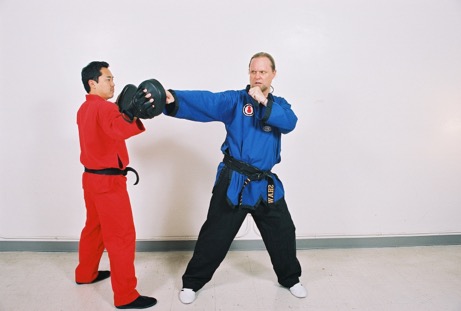
The Straight Punch
The straight punch is one of the essential tools of taekwondo’s punching arsenal. The straight punch uses the front fist. It is understood that this punch is generally the first line of defense one should turn to for self-defense applications, as it is a natural, easy, and very debilitating technique of self-defense.
The taekwondo straight punch is driven forward, directly towards your target, in a linear fashion. Your shoulder muscles and triceps are the bodily tools used to propel your fist forward. Your fist can make contact with your opponent in either a vertical or horizontal positioning.
The taekwondo straight punch is ideally delivered when the elbow of your punching arm remains slightly bent upon making target impact. This is initially accomplished by accurately judging the distance between you and your opponent. You then make striking impact with your opponent before your arm reaches the point where it must stretch out or extend unnaturally to reach its desired strike point. By allowing your elbow to remain slightly bent, whenever you use a straight punching technique, you not only maintain maximum body balance but you keep your elbow from possible hypertension, as the momentum of the punch drives it forward.
The key element that gives the taekwondo straight punch its power is the fact that you make contact with your target before you have extended your punching arm fully. The reason for this is so that your straight punch reaches its target as close to its point of inception as possible. This allows you to continue forward with the force and power of the punch — extending it deeply into your opponent. If, on the other hand, you have to reach to make contact with your opponent, you will have utilized and wasted a large portion of the power of your punch before it ever impacts its intended strike point.
The Taekwondo Straight Punch Verses the Roundhouse Punch
The reason the practitioner of taekwondo utilizes the straight punch, as the preferred punching technique, is the fact that it holds several advantages over the more common roundhouse punch. The roundhouse punch is delivered when the punching arm initially swings outwards and then in towards its target. Due to its design, the roundhouse punch is not only much slower than the straight punch, but it is much more obvious and easy to defend against, as well.
Other Linear Hand Strike Techniques
Through the design and application of the straight punch, the practitioner of taekwondo delivers other linear hand striking techniques in much the same, very direct manner. By this style of application, these techniques not only become very fast and powerful but they additionally become very hard to block — due to the extremely linear nature of their delivery.
The Knuckle Fist (Jin Joo Mok)
The knuckle fist is formed by making your hand into a fist. You then cause your forward knuckles to extend forward. Offensive delivery is made with this weapon of the hand by projecting your bent elbow from mid body level. The forward motion of this punch is driven forward with your shoulder and arm muscles. As the knuckle fist is a refined and highly specific striking tool, its impact is ideally delivered to the solar plexus or central throat of an opponent.
The Circle Hand (Won Yuk Soo Do)
The circle hand is formed by separating your thumb from your forefinger, tightening the muscles and tendons of the hand, and striking, in a linear fashion, to the frontal region of an attacker’s neck. The circle hand, which strikes an opponent’s throat, is also immediately delivered in a very linear style of attack. From this, the opponent is struck and debilitated before he has the opportunity to block this offensive technique.
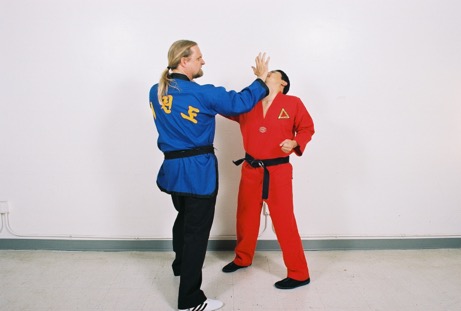
The Palm Strike (Chang Kwon)
The palm strike, like the straight punch, is delivered in a very linear fashion. The palm strike has you bend your fingers at your second knuckle, which exposes the base of your palm. By bending your fingers in this fashion, the muscle that extends from your thumb across the base of your hand is tightened, thus providing a powerful striking weapon. Your palm is then brought back to your shoulder level. It is unleashed by snapping the strike towards its target with your shoulder muscles.
The palm strike is most effectively used to target locations on your opponent’s head such as: underneath the base of his nose, (which can prove deadly), across the bridge of his nose, his temples, or the side of his jaw.
The Back Fist (Ye Kwon)
The use of the back fist, in modern taekwondo, has virtually disappeared. This offensive technique was, however, an integral part of the original teachings of this art.
The back fist is an extremely rapid offensive weapon. To unleash the back fist, your elbow is bent and your fist is brought back to your chest at shoulder level in a vertical position. The back fist is then unleashed at its target by first snapping your elbow out and then extending the distance of the back fist’s attack from your shoulder. The back fist is generally aimed at your opponent’s head.
The back fist is extremely difficult to defend against. This is due to the fact that it is a very rapid striking weapon and once impact is made, your fist is rapidly recoiled. The back fist can, therefore, be used multiple times when additional striking measures are necessary.
The Bottom Fist (Yoo Kwon)
The bottom fist is formed in a traditional fist fashion. The striking element of this weapon is the base of your hand, between your wrist and the base of your little finger. The bottom fist is delivered in a downward striking motion. It is ideally targeted at the top of the head, or the bridge of the nose of your opponent when you are both in a vertical position. In other instances, this strike can be used to strike downward to any location on your opponent’s body you find open for immediate attack.
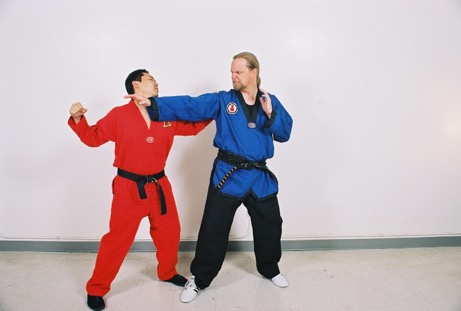
The Knife Hand (Soo Do)
To form the knife hand, the fingers are extended and the muscles and tendons in the hand and wrist are tightened. The initial mistake many novice taekwondo practitioners make when attempting to use the knife hand as a weapon is to relax the tension in their hand, either just before or when the knife hand strikes. This should never be done, for you can easily break bones in your hand.
The basic strike weapon of the knife hand is along the base of the hand. This extends from where the wrist ends to where the little finger begins. This is along its arched side and is the location where the knife hand develops the most strength by the aforementioned tightening techniques.
The extension of the arm and then the snapping of the elbow propel the knife hand strike. The momentum developed by the snapping out of the elbow should never be allowed to entirely control your knife hand assault. The elbow should remain slightly bent when the knife hand technique is delivered, thus maintaining control over your movement.
The knife hand is not a randomly effective weapon such as the fist -- which can be allowed to strike virtually anywhere on an opponent’s body. Instead, the knife hand is ideally suited to strike very specific locations on an opponent’s body: the front of his neck, across his nose, to his temples, and the side of his ribs.
The Inside Knife Hand (Yuk Soo Do)
The inside knife hand is formed in much the same way as the traditional knife hand. Initially, the muscles of the fingers and hand are tensed. The difference between this offensive technique and that of the traditional knife hand is that impact is made with the inside ridge of your hand. To this end, the thumb of the striking hand is pulled tightly into the palm, thereby exposing the inner ridge of the hand.
Due to the fact that it is very easy to damage the hand and thumb if the technique is unleashed improperly, this advanced taekwondo hand striking technique is only used by the most advanced practitioners who truly understand this hand technique’s proper usage. The ideal opponent striking techniques to be impacted by the inside knife hand are the side of an opponent’s neck, the front of his neck, and across the bridge of his nose. As this technique does not possess a lot of power, it is not an ideal technique to be used on other, firmer, bodily locations.
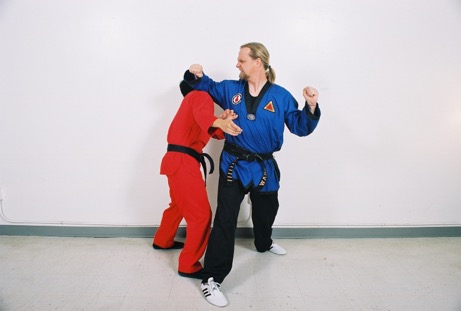
The Elbow Strike (Keum Chi)
As can be seen in a number of taekwondo forms, the elbow strike is a commonly employed tool of offense and defense. To the taekwondo practitioner, the elbow becomes an exacting weapon in numerous self-defense applications.
The forward elbow strike witnesses you bending your elbow, exposing the protruding elbow bone at the base of your forearm. This bone is your striking tool. This forward elbow strike is ideally targeted at a vital strike point on your opponent’s head.
To perform the forward elbow strike, bring your elbow up to shoulder level and pivot your body at waist level. By stepping in with your lead foot, you make an extremely powerful impact to your target.
The forward elbow strike is an ideal weapon to be used in close contact in-fighting. It is an ideal weapon on your opponent when your opponent is moving in on you or has taken a powerful forward hold on your body. The ideal strike points for this type of defense are your opponent’s temples or any place on his face.
The rear elbow strike is an ideal weapon to use if an attacker has grabbed a hold of your body from behind. If you have been grabbed from behind, the rear elbow strike witnesses you pivoting backwards, unleashing your bent elbow from shoulder level, making impact to virtually any part of your attacker’s body, but most ideally to his head and face.
If you have not yet been grabbed from behind but your attacker is close, you can add the additional momentum driven movement of your body into the strike by pivoting at your waist level, as your rear elbow strike is unleashed.
Using the Entire Art
As can be easily understand, taekwondo utilizes much more in its self-defense arsenal than simply its feet. It also takes the hands and arms of the practitioner and turns them into exacting tools of self-defense. Though this expansive system of self-defense has continued to be refined over the decades, instead of diminishing its techniques it is essential that the true taekwondo enthusiasts continue to embrace all aspects of the art, thereby make the practitioner a more complete and well-rounded martial artist.
Copyright © 2009 — All Rights Reserved